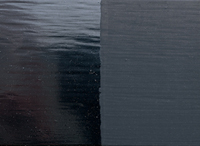 CAUSES: Alligatoring is seen as pronounced wide cracks over an entire surface. These cracks do not reach the substrate; they may affect a single layer of coating film only. Alligatoring may begin as checking or cracking, but the breaks tend to grow wider at the bottom as well as at the top. The top coating contracts, thus exposing portions of the undercoat. In an extreme case of alligatoring, the islands of coating between interlacing breaks have not only contracted in area but have increased in thickness and consequently often become wrinkled.
CAUSES: Alligatoring is seen as pronounced wide cracks over an entire surface. These cracks do not reach the substrate; they may affect a single layer of coating film only. Alligatoring may begin as checking or cracking, but the breaks tend to grow wider at the bottom as well as at the top. The top coating contracts, thus exposing portions of the undercoat. In an extreme case of alligatoring, the islands of coating between interlacing breaks have not only contracted in area but have increased in thickness and consequently often become wrinkled.
Alligatoring is often caused by the inability of the topcoat to bond smoothly to a glossy coat beneath it. A glossy finish is too hard to provide a good bond. In addition, application of an extremely hard coating over a soft primer can result in alligatoring. Alligatoring also may be caused by allowing insufficient time for the undercoat to dry before recoating.
Another possible cause is the natural aging of oil-based paints in extreme climates of freezing and thawing or where the moisture absorption/drying out process, in conjunction with everyday expansion and contradiction, results in a loss of paint film elasticity.
Other possible causes include application of a shorter oil-type finish over a longer oil-type undercoat or primer. This problem is magnified if the finish is applied prior to the undercoat being completely cured. Another cause is an excessively thick application of coatings.
SOLUTIONS: Remove old paint completely by scraping and sanding. Removal of large areas can be done quickly by power washing or with the use of a heat gun. Prime with either a high-quality latex or oil primer, and paint with either oil or acrylic latex house paint.






































